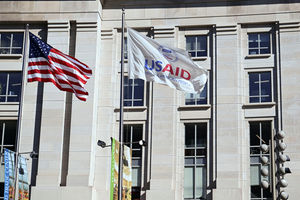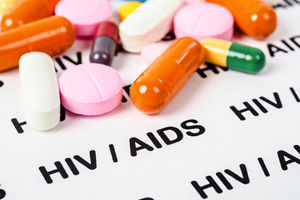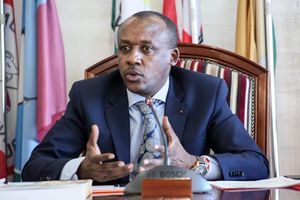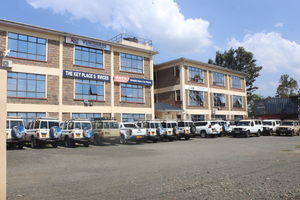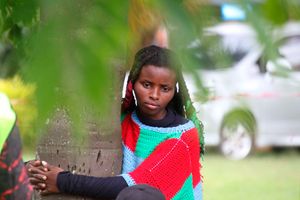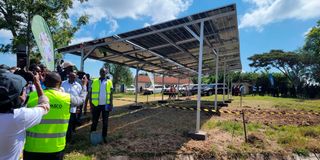
Newly installed solar system in Nomotio water treatment plant in Samburu County. The project was funded by USAID.
If the money Kenya has received from USAID over the past 24 years were injected into the current fiscal year’s budget, it would account for a third of it—twice the amount the government expects to spend on development—highlighting the significance of Washington's aid and the impact its withdrawal would have.
An analysis of data on the funding from the United States Agency for International Development (USAID) from Presidents George W Bush, Barack Obama, Donald Trump’s first team, and Joe Biden from 2001 to 2024 shows the fight against HIV and responding to emergencies such as floods and drought are the most exposed areas amid a looming end to funding from the aid agency.
This is as data from the US Foreign Assistance show that about two-thirds of USAID funding to Kenya over the past two decades has gone towards the two areas, underlining the impact it has had on some of Kenya’s biggest health and climate change problems.
From 2001 to 2024, USAID gave Kenya $9.74 billion (Sh1.26 trillion as per current official exchange rates) in aid.
Money coming from USAID has constituted 68.3 per cent of all the aid coming from the US (totaling Sh1.84 trillion) since 2001.
Majority of the money that Kenya received through the aid agency went into various health programmes such as the fight against HIV/Aids, maternal and child health, family planning, emergency response during drought and floods, as well as towards food security programmes.
A deeper analysis of the data shows that Kenyans living with HIV/AIDS have been the biggest beneficiaries of the USAID programmes in the country, receiving Sh504 billion (40.1 percent) of the USAID funding since 2001.
Funding to aid response to emergencies such as floods, drought and other calamities accounted for a quarter of the USAID funding over the past 24 years, and has been the agency’s top priority over the past five years, the data shows.
Fears are high that funding from the agency the US government has been using to offer foreign assistance in key areas such as health, security and agriculture could be coming to an end after President Trump’s administration called for its closure.
Already, organisations that have been partnering with USAID to deliver on different programmes have received instructions to stop operations where the agency is offering funding until a final determination on USAID’s fate is issued in three months’ time.
“Amref has received stop-work orders from the US government which we have complied to because the US government has been clear that the stop-work orders are for 90 days pending review and advice. In the meantime, that means that we have to stop work and therefore we’ve stopped work as instructed and we will be moving forward based on instructions we receive from the US government,” Amref Health Africa CEO Githinji Gitahi said.
Dr Githinji noted that while the instructions from the US government have been limited to the temporary stop-work, key programmes on HIV care and treatment and maternal health where Amref, the largest Africa-based healthcare non-profit currently present in 35 countries, has been partnering with USAID are at risk, should funding be withdrawn after the 90 days.
Funding to HIV/AIDS programmes accounted for 40.1 per cent of all USAID funding to Kenya since 2001, and 30.1 percent of its funding to Kenya over the past five years.
USAID and its partners say that their programmes on HIV/AIDS in the country have provided testing services to more than 8.5 million Kenyans and about 120,000 people living with HIV/AIDS are on medicines courtesy of the programmes.
“If the USAID funding was not available, of course, there will be more money out of pocket because if the government cannot fill the gap as required specifically for the US government’s contribution to HIV treatment which is about Sh40 billion annually, then individuals will have to pay for services out of pocket which will increase the cost of care,” Dr Githinji notes.
Sh28 billion funding gap
A brief by the Council of Governors (CoG), the National Syndemic Disease Control Council (NSDCC), Kenya Medical Supplies Authority (Kemsa) and the National AIDS and STIS Control Programme following the US government action shed more light on possible impacts of an end to the USAID funding in the country, noting that it would leave a Sh28 billion funding gap to HIV treatment and care services alone.
The agencies noted that USAID was expected to provide 28 percent of the required funding to all HIV services that include purchase of commodities and payment of frontline workers.
The sudden move by President Trump’s administration has left Kenya largely exposed as it faces possible cases of shortages of HIV drugs and the agencies have called on the government to make an urgent allocation of about Sh14 billion to avert shortages and stock-outs.
“Liaise with the Global Fund for HIV, Tuberculosis and Malaria to seek the possibility of bringing forward the procurements committed under FY 2025/2026 to FY 2024/2025 to avert stock-outs as a result of required procurement lead time,” the brief also advised.
The agencies also noted that the government would need to allocate Sh28 billion annually going forward to fully finance the requirement for HIV commodities.
The US government data notes that maternal and child health received Sh57.31 billion in the last 24 years while other health programmes received Sh96.04 billion.
Another big beneficiary of USAID funds were emergency response initiatives with Sh308 billion being sent to Kenya since 2001.
These funds were used to deal with the aftermath of drought and floods in various parts of the country.
Big problem
Droughts and floods have particularly been a big problem that has left farmers counting losses as crops and livestock were lost to the climatic calamities in recent years.
Since 2019, emergency response accounted for the highest share of funding from USAID with Kenya receiving $854 million (30.8 percent of all USAID funding during the period).
The funding to emergency response over the past five years was followed by funding to HIV/AIDS programmes which received $836 million, and funding to basic health programmes which received $312.1 million.
Another sector where USAID funds were channelled was towards agriculture with the country receiving $36.65 million in 2024 and a total of Sh83.27 billion since 2001.
A comparison of the different administrations shows that during President George Bush’s two terms, $1.1 billion was disbursed to Kenya through USAID, and then $4 billion came in during Barrack Obama’s tenure between 2009 and 2016.
During President Trump’s first term between 2016 and 2020, $2.3 billion was disbursed through the aid agency while in President Biden’s term, $2.2 billion was sent to Kenya.
The 2011/2020 decade saw USAID funding to Kenya nearly triple (2.9 times) as compared to the funding received between 2001 and 2010.
Most organisations within the government and others that have been closely involved in USAID programmes avoided discussing the subject publicly, referring the Nation to government officials for responses.
Services and drugs
Organisations from across the continent have sounded alarm that a withdrawal of funding to health, security and emergency response programmes could affect millions of people who have relied on such programmes for survival.
Some of the organisations that received stop-work orders from the US government have closed drop-in centres and others have warned that patients could experience mental health falls as they miss much-needed services and drugs.
And while the organisations hold onto hope that the US government could reconsider the decision, the Trump’s administration was busy removing signage on its headquarters in Washington D.C on Friday, sending signals across the world that its fate has already been sealed.
Dr Githinji noted that a withdrawal of the USAID funding would leave the government with the alternative of seeking funding from other donors and philanthropists, or mobilizing domestic resources from the private sector
“We cannot say that USAID has withdrawn resources. For now, we take it that USAID support to Africa and Kenya specifically is still on the table because we have not yet received instructions for withdrawal, we have received instructions for a stop-work order awaiting review,” he said.


